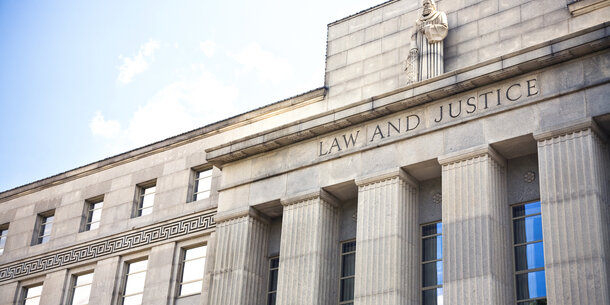The presidential election may be first on voters’ minds this year, but under-the-radar judicial races will affect our democracy no matter what happens at the federal level. Across the country, one of every five seats on state high courts is on November’s ballot. In all, voters will elect 66 justices in 31 states, including battlegrounds Michigan, Ohio, and North Carolina. As in prior years, the Brennan Center will track, analyze, and publish data on spending in each of this November’s supreme court elections. (This data and all of the television ads in these races will be available at our Buying Time resource).
State supreme courts have significant power to limit rights and freedoms. In the spring, high courts in Wisconsin and Texas rejected government officials’ attempts to make voting safer amid the global pandemic. And many state high courts have established qualified immunity for police officers, insulating them from civil liability for misconduct.
At the same time, however, some state high courts have gone much further in protecting rights than the U.S. Supreme Court has. Last year, the Kansas Supreme Court held that the state’s constitution protects reproductive choice, regardless of what SCOTUS decides. And though the U.S. Supreme Court ruled last year that it would not rein in partisan gerrymandering, state courts in Pennsylvania and North Carolina have invoked state constitutions to strike down partisan manipulations of the redistricting process, rejecting congressional districts in Pennsylvania and both congressional and legislative districts in North Carolina. And while the U.S. Supreme Court greenlit the Trump administration’s decision to resume federal executions, the Washington Supreme Court in 2018 declared the death penalty unconstitutional in the state.
With so many critically important judicial elections taking place across the country this November, several key themes will become apparent.
Money will likely flow into Michigan and Ohio, where court majorities are up for grabs. Spending in a particular judicial election often balloons when the election outcome could flip a court’s ideological or partisan balance, ultimately altering key decisions. In both states, which hold partisan judicial elections, enough seats are up this year to determine whether Democrats or Republicans comprise a majority on their courts. (For more details on how partisanship plays into each of these states’ elections, see our Judicial Selection Map).
Intensifying the partisan stakes, the resulting majorities on these courts will likely be in a position to resolve disputes related to the decennial redistricting that will take place next year for both congressional and state legislative offices.
National dark money is likely to play an outsize role. Since Citizens United, national special interest groups have dramatically expanded their presence in state supreme court elections. In the last presidential cycle, these special interest groups accounted for 40 percent of all money spent in state supreme court races across the country, and in some states they were responsible for more than three-quarters of all spending. The source of much of this money is almost entirely opaque; as a 2017 Brennan Center study determined, voters can learn the true source of as little as 20 percent of interest group expenditures. This secret money keeps voters from knowing who is trying to influence their elections, thus obscuring conflicts of interest when the interests of secret campaign funders come before the judges they helped elect.
These spenders have also been more willing than individual judicial candidates to run misleading attacks on their opponents. One potential consequence is simultaneously harmful and ironic: research suggests that ads labeling particular jurists as soft on crime may lead these judges to avoid such attacks by rendering harsher decisions in criminal cases in election years.
The largest national interest group spender in recent elections has been the Republican State Leadership Committee (RSLC), which spent $6 million in 2016 and $4 million in 2018 to influence judicial elections in five states. The RSLC itself received millions from the Judicial Crisis Network, the leading dark money funder of recent SCOTUS nomination fights. With the majorities on courts in battleground states up for grabs this year, we expect both groups to engage once again.
These elections will not substantially improve the dismal lack of racial and ethnic diversity on most supreme courts. Twenty-three states today have all-white high courts, including 12 states where people of color make up more than 20 percent of the population. At a time when the public is demanding racial equity in the justice system, this failure of representation undermines public confidence, renders judicial decision-making less informed, and in some states continues the development of centuries of legal jurisprudence without the perspectives of judges of color. Six states with an all-white bench are holding a supreme court election this November, and in each one, voters will confront exclusively white candidates on the ballot. Among them are Nevada, Alabama, and Michigan, where people of color make up more than a quarter of each state’s population.
Judicial elections will take place amid widespread calls for criminal justice reform. At a time when the public is reckoning with the violence perpetrated by the police and abetted by prosecutors, comparatively little attention has focused on state high courts. Yet state supreme court justices have the final say on questions of state criminal law, including civil immunity for police officers, and they often set statewide judicial policy on fees, fines, and related matters. In the past, judges and the interest groups supporting them have appealed to voters using tough-on-crime rhetoric, but this year’s elections provide an opportunity for courts to address their role in the current movement toward a more humane justice system.
State courts hear 95 percent of all court cases in the United States, and in some of the highest-profile policy fights to come — reproductive rights, access to public education in the time of a global pandemic, police violence, criminal justice reform — these courts will have the final word. We will be watching to see who tries to determine their composition in this year’s elections, and you can follow along at Buying Time.



